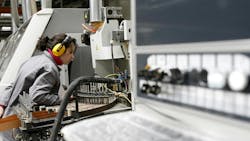‘Digital retrofitting’ of plant machines offers course through Industry 4.0 to Industry 5.0
What you’ll learn:
- IoT shows no sign of slowing down—with IoT devices in manufacturing projected to nearly double from 103 million in 2022 to 200.5 million by 2030.
- The change to cyber-physical production systems (CPPS) that integrate physical machines with digital platforms will lead to new innovations in the production processes.
- Digital retrofitting involves outfitting legacy machines with sensors retroactively to enable data collection.
When homeowners remodel their homes, they often try to incorporate as many original elements of the house as possible to save money. Similarly, manufacturers face cost concerns as they move from the promise of Industry 4.0 and smart manufacturing toward the humanistic, future-looking vision of Industry 5.0.
See also: Sensing a shift: Trends in smart industrial automation
As IoT shows no sign of slowing down in the world of industry—with IoT devices in manufacturing projected to nearly double from 103 million in 2022 to more than 200 million by 2030—manufacturers need to keep pace in order to stay competitive.
One of the most pragmatic strategies to make this jump lies in digital retrofitting—or enabling existing plant equipment to join the connected world of smart manufacturing without wholesale replacement.
While Industry 4.0 emphasizes data and automation, Industry 5.0 elevates the framework by making it more human-centric—ensuring manufacturing is better for both workers and the planet.
It aims to use advanced technologies like AI, enhancing human-in-the-loop workflows to reduce bias from algorithms and train existing workers in new skills. It also aims to align with wider goals like climate neutrality, which is important as regions such as the EU push toward sustainability.
Taking part in Industry 5.0 ensures manufacturers stay competitive and resilient.
For example, leveraging AI can help manufacturers quickly sort through scores of data to find and track issues, aiding human decision-making with technological power.
Taking part in Industry 5.0 ensures manufacturers stay competitive and resilient, creating supply chains that can create new efficiencies and adapt to changing market conditions as necessary.
The challenge of legacy equipment
Industrial machinery often has a service lifespan stretching decades. This durability is a double‑edged sword: While this machinery represents vital capital, much of it lacks the connectivity and data-rich interfaces of many of today’s devices—hindering manufacturers’ ability to respond to the call of Industry 5.0.
Picture your supervisors still walking around with printed spreadsheets; that’s just not ideal for today’s connected industrial sphere.
See also: Manufacturers struggle with outdated systems and short staff, but external IT can help
About 70% of manufacturing devices constitute legacy, non-IoT machines—meaning there’s a lot to modernize. Costs remain high; the cost of manufacturing machinery maintenance alone ranges from 15% to 70% of the cost of goods produced, so any updates to machinery need to be well-considered. That’s why many manufacturers combine legacy and new machines on their shop floors, balancing cost concerns with modern needs.
Retrofitting has emerged as a financially viable alternative to outright machine replacement to meet Industry 4.0 demands. This can help legacy machines, part of your operational technology portfolio, that are in otherwise perfect working condition offer real-time data and integration with newer machinery.
What digital retrofitting entails
Digital retrofitting involves outfitting legacy OT with sensors retroactively to enable data collection. From there, manufacturers can leverage edge computing technologies—such as gateways or edge devices—to translate legacy protocols into formats compatible with IoT so they can communicate with other machines.
See also: Predictive maintenance: The data-driven answer to manufacturing's $50 billion problem
These upgrades transform standalone equipment into cooperative nodes within the entire system, laying the groundwork for modern capabilities such as analytics and automation.
A systematic retrofit journey begins with a comprehensive audit that involves assessing your current capabilities and process requirements. Following this, organizations can deploy:
- Sensor networks for monitoring things like vibrations and temperature.
- Protocol bridges or gateways to translate legacy signals into modern industrial IoT streams.
- Middleware and edge computing to manage data flow and interoperability with cloud or enterprise systems.
This retrofitting process is not without obstacles, however. Protocol incompatibilities and technical debt can complicate the process, particularly when connecting older control systems to newer IoT stacks.
Retrofitting has emerged as a financially viable alternative to outright machine replacement to meet Industry 4.0 demands.
Webinar replay: Cybersecurity Challenges, Brought to You by AI
It’s important to work with a qualified partner when engaging in retrofitting to anticipate and mitigate these risks. Deploying an IoT platform can help by creating an abstract layer to collect data from any machine and create metadata that can integrate with any IT system.
The value of retrofitting for Industry 5.0
From the cost-effectiveness of retaining an organization’s investment in physical assets to the value gained from new analytics and automation capabilities, retrofitting for Industry 5.0 has myriad benefits that set manufacturers apart.
See also: Zero-trust cybersecurity for increasingly interconnected OT
Retrofit solutions can be applied modularly and piloted quickly, delivering early ROI on elements such as predictive maintenance and energy optimization.
By deploying powerful IoT solutions on existing machines with a trusted partner, manufacturers of all sizes can advance toward a future in which people and machines thrive in unison.
About the Author

Bill Dykas
Bill Dykas is senior product manager for Telit IoT Platforms and has over 15 years of business and market development experience in several technology categories. His experience with RFID, Big Data analytics, pervasive computing and Software-as-a-Service (SaaS)-based strategies supports his interests in the IoT marketplace. At Telit Cinterion, he works to develop products and services that connect and integrate machines with enterprise IT systems.
